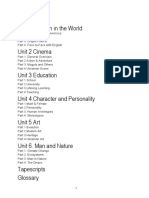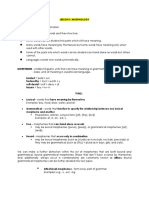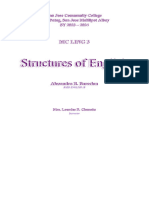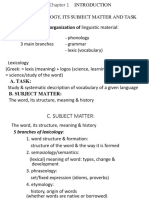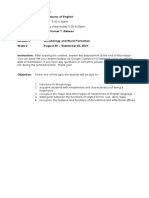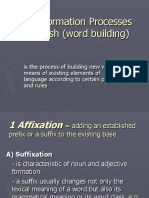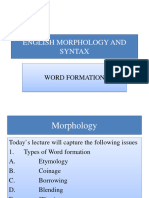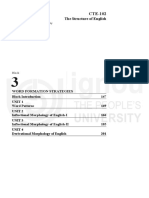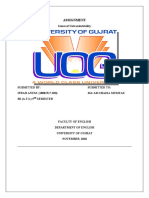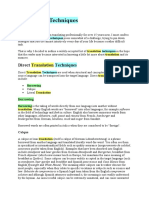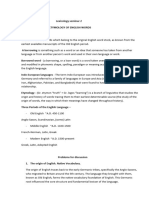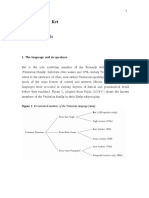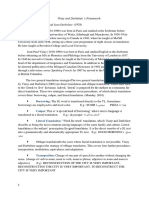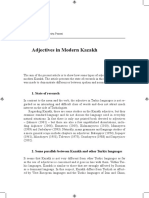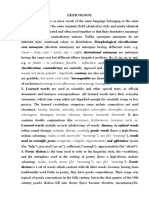0 ratings0% found this document useful (0 votes)
17 viewsFrancis_Katamba_English_Words-3
Uploaded by
Mohammad AlamCopyright
© © All Rights Reserved
We take content rights seriously. If you suspect this is your content, claim it here.
Available Formats
Download as PDF, TXT or read online on Scribd
0 ratings0% found this document useful (0 votes)
17 viewsFrancis_Katamba_English_Words-3
Uploaded by
Mohammad AlamCopyright
© © All Rights Reserved
We take content rights seriously. If you suspect this is your content, claim it here.
Available Formats
Download as PDF, TXT or read online on Scribd
You are on page 1/ 3
vi
3.6.1 Tiny words (isolating languages) 30
3.6.2 Get the glue (agglutinating languages) 31
3.6.3 Labyrinthine words (synthetic languages) 31
3.6.4 Verbal juggernauts (polysynthetic languages) 33
3.6.5 No thoroughbreds 33
3.7 Summary 35
Exercises 35
4 Building words 37
4.1 Words and jigsaws 37
4.2 Know the pieces of the jigsaw 37
4.2.1 Roots are the core 37
4.2.2 Affixes are for appending 38
4.3 The main types of word-building: inflection and derivation 40
4.4 Derivation: fabricating words 41
4.4.1 Affixation: prefixes and suffixes 42
4.4.2 Conversion 48
4.4.3 Compound parade 49
4.4.4 Wishy-washy words 54
4.5 Summary 55
Exercises 55
5 Masquerading allomorphs 57
5.1 The right mask 57
5.2 Phonologically conditioned allomorphs 57
5.2.1 Selecting underlying representations 61
5.2.2 Derivations 63
5.3 Phonology in the shade: lexical and grammatical conditioning 65
5.4 Madness without method: suppletion 66
5.5 Summary 66
Exercises 66
6 A lexicon with layers 69
vii
6.1 The nature of the lexicon 69
6.2 Morphological information in the lexicon 70
6.3 Syntactic information in the lexicon 70
6.4 Does it ring true (phonological information) 71
6.5 Rendezvous with lexical phonology and morphology 71
6.5.1 Neutral and non-neutral affixes 72
6.5.2 The lexicon is like a layered cake 73
6.6 Productivity, the time-warp and cranberries 77
6.7 Peeping beyond the lexicon 79
6.8 Summary 80
Exercises 80
7 Should English be spelt as she is spoke? 83
7.1 Writing systems 83
7.2 Is the English orthography mad? 84
7.2.1 The apparent madness in the English spelling system 85
7.2.2 There is a method in the madness: spelling rules and pronunciation 86
7.2.3 Is A for apple? Why vowel letters pinch like ill-fitting shoes 90
7.3 Morphological signposts in the spelling 94
7.4 Lexical signposting in the spelling 96
7.5 Spelling reform 96
7.6 Is speech degenerate writing? 99
Exercises 101
8 Word manufacture 103
8.1 The production line 103
8.2 Keeping tabs on idioms 106
8.3 Clitics 108
8.4 Summary 111
Exercises 111
9 Words galore 113
9.1 A verbal bonanza 113
viii
9.2 Jargon 113
9.3 Slang 114
9.4 Clichés and catch-phrases 115
9.5 A rose by any other name 119
9.5.1 Semantic widening 120
9.5.2 Semantic narrowing 121
9.5.3 Going up and down in the world 122
9.5.4 Loss account 122
9.5.5 Lexical revivals 124
9.5.6 Metaphors 124
9.6 Clipping 124
9.7 Acronyms and abbreviations 126
9.8 Fads and copycat formations 127
9.9 Back-formation 128
9.10 Blends 128
9.11 Euphemism 129
9.12 Summary 131
Exercises 131
10 A lexical mosaic: sources of English vocabulary 133
10.1 The nature of borrowing 133
10.1.1 Direct and indirect borrowing 133
10.1.2 Loanwords and loanshifts 134
10.1.3 Likely loans 135
10.1.4 Why borrow? 135
10.1.5 The grass is ever greener on the other side 138
10.1.6 Nativisation of loanwords 139
10.1.7 Effects of borrowing 142
10.2 Scandinavian loanwords 143
10.3 The French influence 144
10.3.1 The Norman French legacy 144
You might also like
- 100 Easy Ukrainian Texts: Ukrainian Language Reader for Beginners with Audio and ExercisesFrom Everand100 Easy Ukrainian Texts: Ukrainian Language Reader for Beginners with Audio and ExercisesNo ratings yet
- Word Formation Processes: Second, New Words Can Enter A Language Through TheNo ratings yetWord Formation Processes: Second, New Words Can Enter A Language Through The11 pages
- Introduction To Linguistics II: Ling 2-121C, Group BNo ratings yetIntroduction To Linguistics II: Ling 2-121C, Group B33 pages
- Ling111 Lecture Notes Week 1-2 Fall 2017No ratings yetLing111 Lecture Notes Week 1-2 Fall 201719 pages
- MC LING 3 - Structure of English - Alezandra Barcelon 1B - PRELIM OUTPUTNo ratings yetMC LING 3 - Structure of English - Alezandra Barcelon 1B - PRELIM OUTPUT8 pages
- The Role of Morphology in English Vocabulary TeachNo ratings yetThe Role of Morphology in English Vocabulary Teach4 pages
- English Hsmc201 Study Material Even 2025No ratings yetEnglish Hsmc201 Study Material Even 202576 pages
- Riassunto Inglese - Word Formation ProcessesNo ratings yetRiassunto Inglese - Word Formation Processes3 pages
- Fariz Fadillah Akbar - 190511100086 - Final Test LexicographyNo ratings yetFariz Fadillah Akbar - 190511100086 - Final Test Lexicography7 pages
- I. Lexicology, Its Subject Matter and Task The Linguistic Organization of Linguistic MaterialNo ratings yetI. Lexicology, Its Subject Matter and Task The Linguistic Organization of Linguistic Material79 pages
- Word-Formation Processes in English (Word Building) Meeting 2No ratings yetWord-Formation Processes in English (Word Building) Meeting 214 pages
- The Structure of English: Word Formation StrategiesNo ratings yetThe Structure of English: Word Formation Strategies77 pages
- Processes of Word Formation I DefinitionNo ratings yetProcesses of Word Formation I Definition19 pages
- Mastering Grammar: A Comprehensive Guide for TESOL TeachersFrom EverandMastering Grammar: A Comprehensive Guide for TESOL TeachersNo ratings yet
- IBM Global High Resolution Atmospheric Forecasting FINALNo ratings yetIBM Global High Resolution Atmospheric Forecasting FINAL1 page
- Buyingorsellingmotorvehicle Just The FactsNo ratings yetBuyingorsellingmotorvehicle Just The Facts2 pages
- 3.6 Greenhouse Gases and Energy DEIR PDFNo ratings yet3.6 Greenhouse Gases and Energy DEIR PDF3 pages
- PPL Advice 19 03 Attach B Strikethrough TRF Sch135 6 13 19No ratings yetPPL Advice 19 03 Attach B Strikethrough TRF Sch135 6 13 192 pages
- AdditionalProductGuide CompanyBillStatements ForAdminsNo ratings yetAdditionalProductGuide CompanyBillStatements ForAdmins9 pages
- Lexicology With Etymology First AssignmentNo ratings yetLexicology With Etymology First Assignment7 pages
- Loanwords in Romanian: 1. The Language and Its SpeakersNo ratings yetLoanwords in Romanian: 1. The Language and Its Speakers37 pages
- Andersen 2003 Language Contacts in Prehistory Studies in Stratigraphy100% (1)Andersen 2003 Language Contacts in Prehistory Studies in Stratigraphy301 pages
- Chapter 5: Word Formation: Presented By: Ms. Sadaf SiddiqNo ratings yetChapter 5: Word Formation: Presented By: Ms. Sadaf Siddiq16 pages
- German-English Cognates Same or Similar Words Used in German and EnglishNo ratings yetGerman-English Cognates Same or Similar Words Used in German and English11 pages
- Translation Strategies Employed by Mona Baker When Translating TheNo ratings yetTranslation Strategies Employed by Mona Baker When Translating The5 pages
- Complete Download Studies in the History of the English Language V Variation and Change in English Grammar and Lexicon Contemporary Approaches 1st Edition Robert A. Cloutier (Ed.) PDF All Chapters100% (2)Complete Download Studies in the History of the English Language V Variation and Change in English Grammar and Lexicon Contemporary Approaches 1st Edition Robert A. Cloutier (Ed.) PDF All Chapters77 pages
- Munday (2016) - Vinay Darbelnets ProceduresNo ratings yetMunday (2016) - Vinay Darbelnets Procedures4 pages
- Vinay and Darbelnet Direct and Indirect MethodNo ratings yetVinay and Darbelnet Direct and Indirect Method3 pages
- PPT- Lexicology I. History borrowings.ppsNo ratings yetPPT- Lexicology I. History borrowings.pps15 pages
- Root Antonyms (Absolute Antonyms) Are Antonyms Having Differrent Roots, E.GNo ratings yetRoot Antonyms (Absolute Antonyms) Are Antonyms Having Differrent Roots, E.G9 pages
- Studies in Contrastive Linguistics and StylisticsNo ratings yetStudies in Contrastive Linguistics and Stylistics19 pages
- Georgeta Ciobanu-Romanian Words of English Origin100% (2)Georgeta Ciobanu-Romanian Words of English Origin138 pages
